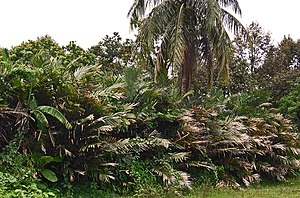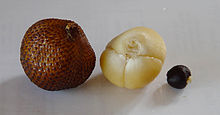Salak palm
| Salak palm | ||||||||||||
|---|---|---|---|---|---|---|---|---|---|---|---|---|

Salak palm ( Salacca zalacca ) |
||||||||||||
| Systematics | ||||||||||||
|
||||||||||||
| Scientific name | ||||||||||||
| Salacca zalacca | ||||||||||||
| ( Gaertn. ) Voss |
The salak palm ( Salacca zalacca ) comes from the Indonesian islands of Sumatra and Java , where it grows in thickets on wet, swampy soils. Because of its edible fruits, it is cultivated in numerous other countries. It is very sensitive to cold and only thrives in the tropics.
description
The salak palm grows up to six meters high. The leaves are feather-shaped, stand in whorls and are 60 centimeters long. The upper side of the leaf is glossy green and the underside of the leaf is whitish green. Almost all parts of the palm above ground are covered by numerous, sharp thorns. The plant is dioecious and the flower is just above the ground, hidden between the leaves. Salak palms spread over subterranean, branched rhizomes and form large, dense clumps.
fruit
The fruits are egg- or pear-shaped and mostly brown to red. The fruit peel is shiny, scaly overlapping and reminiscent of snakeskin. The pulp is light yellow or pink and divided into two to four (usually three) segments. The (uncooked) inedible kernels in the middle of the pulp are brown to black. The taste is reminiscent of pear, lychee and jackfruit . The fruits are offered in local markets. In Europe they are sold under the name "Schlangen (haut) Frucht" (English: snake fruit) or "Salak". In Indonesia, the kernels are boiled in salt water. This creates a layer of mucus that is removed. Then the kernels can be eaten without their shell.
literature
- David Jones: Palms . Könemann, Cologne, 2000, ISBN 3-8290-4889-0
